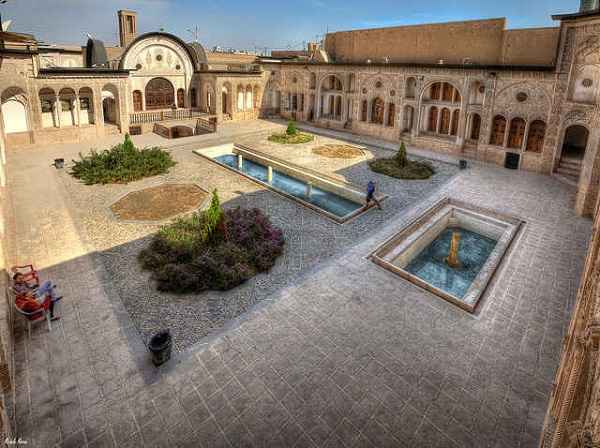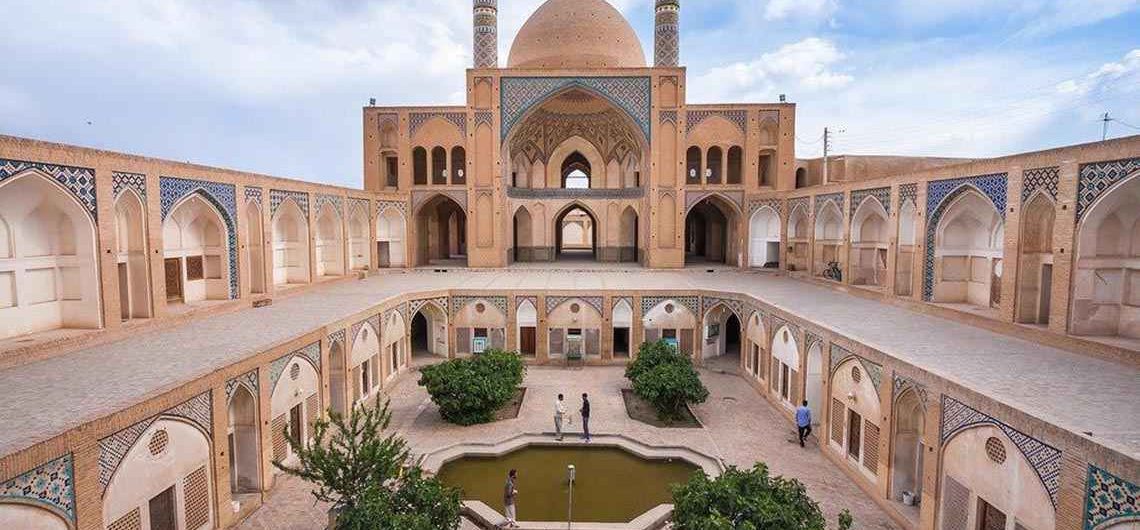Kashan
One of the oldest and most beautiful cities in Iran is thousands of years old. The Sialk Hills, about 3 kilometers west of Kashan, claim that this region was one of the first settlements of humans in Prehistoric times when they built houses using clay and mud. As Kashan has a desert climate and very hot summers, its houses are built in a special way to make it easy to cool or heat the rooms depending on the season. Kashan is an oasis in the Kavir desert where high quality rose water gushes and its carpets and handicrafts are known all over the world. Among the historical monuments of this city we can mention: Mir Emad Mosque, Jomeh Mosque, Agha Bozorg Mosque and Sultan Amir Ahmad Bathhouse.
During the Seljuk dynasty the city was known for its carpets, fabrics and glazed terracotta tiles with metallic reflections, the famous Kashi. Preserved by the Mongols (13th century) and the Tamerlane army (14th century), Kashan benefited from the Safavid kings (1503-1722), who stimulated its commercial and artisan development. Shah Abbas II (1642-1666) chose this city as the Safavid capital. However, the Afghan invasion in the early 18th century and earthquakes prevented its prosperity.
Antiquities of Kashan
Abbasi House
The traditional houses of Kashan with their unique architecture are witnesses of the long history of the city. Of the twenty historic houses in this city, the most interesting are: the Abbasí House, the Tabatabai House and the Borujerdi House.
The Abbasí House, built and furnished at the end of the 18th century, has the beautiful Persian architectural features of the time, mixed with those of Kashan. This house, located next to two large gardens with water tanks, has six internal courtyards around which the buildings housed various families. Some details such as the elaborate stucco ceilings, or the portico (iwan) ceiling, completely covered with fragments of mirrors, mosaics, stained-glass windows and other decorative motifs, all with extreme delicacy, demonstrate the great talent of the Persian architects of the time.

Tabatabai House
A splendid mansion from the Qajar period owned by a wealthy carpet merchant. The history of this house dates back 175 years and is considered an architectural landmark for its beauty. This 4,700-square-meter house has 40 rooms and 4 patios that lacks nothing from the palaces of Persian kings. Some unique features of the architecture of this house are: the garden located below the level of the mansion to heat and cool it depending on the season, and make it anti-seismic. Of great beauty, proportion and aesthetic taste, it stands out for its main patio.
Borujerdi House
Elegant and sober, this traditional house was built by the architect Ali Maryam for the wife of a wealthy merchant in 1857. This house consists of two parts; the exterior (public areas) and interior (private areas), characteristics of traditional Iranian houses, including a courtyard with a fountain and a two-story portico (iwan.) This house has several courtyards and beautiful gardens and is currently the headquarters of the Kashan Cultural Heritage office.
Agha Bozorg Mosque and Madrasa
With original architecture, it is the only mosque in Iran built on the second floor (at the end of the 18th century) by the master Haj Shaban Ali. The first floor is occupied by a Koranic school built by Haj Muhammad Khanban and Mahdi Naraqi for the purpose of studying science and spreading Islam, around a courtyard. This complex belongs to the Qajar period, in which under the meticulous care of Ali Shah Qajar it underwent its development. The building consists of two floors and four arches, two minarets and a brick dome. The two large porticoes (iwans) of the mosque are decorated with red, blue and yellow calligraphy and tiles. This mosque has a symmetrical architecture.
Hammam Sultan Amir Ahmad
Sultan Amir Ahmad’s historic bath belongs to the Seljuk and Qajar periods, and displays a perfect example of impeccable architecture and striking Iranian bath. This bathroom with 1,100 square meters of substructure, spectacular style and architecture and a combination of gold and turquoise blue tiles annually attracts many tourists from all over the world.
Fin Garden
A Persian garden with an area of 23,000 square meters in rectangular shape that belongs to the Seljuk period. During the Safavid and Kayar periods, the garden underwent some changes. The garden was designed by Shah Abbas I (1557-1629) as an earthly landscape of paradise. The concept of the Persian garden attracts the soul when listening to the melody of the spring water overflowing in different channels continuing to flow. In the central area is the Shotor Galu palace (camel throat) which is in charge of distributing water to all the lateral channels. Also in this garden we find the baths of the Safavid and Qajar times. The End Bath was the place where Amir Kabir, a Qajari minister, was assassinated under the ruling of Naser al Din Shah in 1852. There are around 600 cypress and banana trees in this 100-470 year old garden.
Shahzadeh Ibrahim Mausoleum
The mausoleum, built in the Qajar era (1779-1921), is a small grove with sharp points protruding from the square fence walls that houses a beautiful interior garden around a basin of water. Notably, pigeon droppings in the loft on the fence turret fertilize the surrounding arid land. One of the rooms is completely covered in mirrors creating a kaleidoscope, and the alveoli reach up to the ceiling.
Tepeh Sialk
It consists of two mounds from the south and the north, located about 600 meters apart. The artifacts in the northern mounds are older than those in the south. There are relics of two cultural periods, from the beginning of the settlement in the Near Eastern villages to its end, and those of three cultural periods, from the beginning of the settlement in the cities. At the end of the second period, for unknown reasons, the inhabitants of Sialk moved to the southern mound and settled there. Its inhabitants used a script known under the name “Proto-Elamite”, whose signs combined pictograms and numbers (3200 BC).
In view of the use of gray pottery, the last inhabitants of Silak buried their dead in two cemeteries called A and B. The hill was finally abandoned at the end of the Iron Age, before the arrival of the Medes.
Bazar
The liveliest atmosphere in Kashan. It is one of the longest bazaars in Iran that offers the possibility to visit the Saray and the inner courtyards that have kept their typical Iranian and oriental style. Indeed, Saray-e Amin Addoleh is one of the most elegant courtyards in the bazaar, with its central pond surrounded by antique shops and carpets. In addition, next to the central pond there is a cafe, a suitable place to drink tea and contemplate the bustle of the bazaar.
Morshedi cafè
Located on the roof of a restaurant, it stands out for its brick walls, terracotta tiles and wooden ceiling. A good place to try their magnificent expresso, herbal teas, tea, juices and homemade desserts.
Aran-o-Bidgol
One of the cities in the province of Isfahan, originally consisting of two distinct towns “Aran” and “Bidgol”, each with its own customs, social communications and dialects. Given its location near the Silk Road, many caravans crossed it from Europe to the East. About 40 years ago, the wall between these two towns collapsed, and they came together. The existence of hundreds of ancient chains of aqueducts, or kariz, shows the ancient history of development and prosperity of this region. One of the most surprising attractions in this area is the salt lake of Aran-o-Bidgol.
The lake with a length and width of 80 and 30 kilometers respectively is the result of the tectonic sinking of 795 meters above sea level. This site is covered by salt deposits formed over centuries by the accumulation of floods and surface waters. The depth of salt in this area is between 5 and 54 meters, apart from the layers of clay. The water level in the lake reaches two centimeters in some areas during the rainy months and evaporates quickly when it is sunny.
Mashad-e Ardehal Carpet Washing Ritual in Kashan
The term “qalishuyan” consists of two terms: “qali” means carpet or mat and “shuyan”, washed and refers to the ritual of washing the carpets in order to commemorate Soltan Ali, a holy man venerated by the inhabitants of Kashan and Fin. The ritual is celebrated on the Friday closest to the seventeenth day of the month of Mehr (approximately late September and early October) in the solar calendar. On this day, first, the inhabitants of Kave gather at the mausoleum, cry and mourn the saint. They then take a mat to be sprinkled with rose water and hand it over to the inhabitants of Fin and rinse it again under running water and sprinkle it with rose water. In the end, the carpet is taken to the mausoleum. In fact, this carpet is the symbol of the one that had wrapped the martyred body of Soltan Ali.



Comments